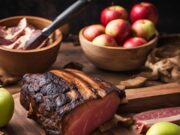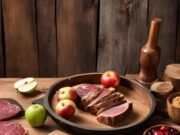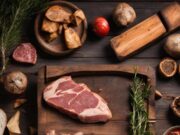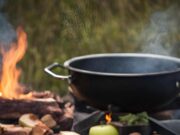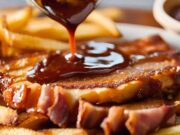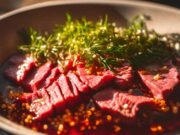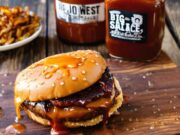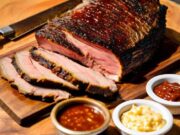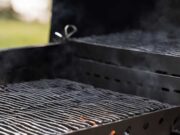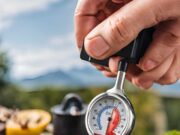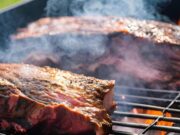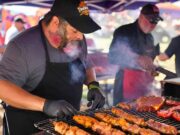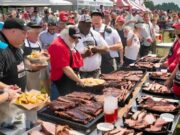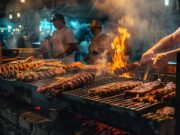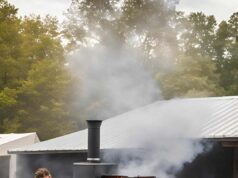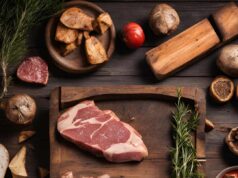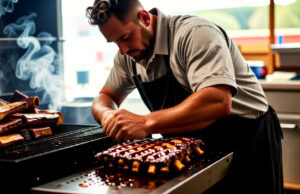Are you prepared to fire up the grill and impress your friends and family? Mastering the art of BBQ may seem daunting, but with the right techniques and tips, anyone can become a grilling professional.
This guide will walk you through everything from selecting the ideal grill—whether gas or charcoal—to essential safety measures and important cooking methods.
You will learn about preheating and seasoning, as well as advanced techniques like temperature control. Get ready to elevate your BBQ skills and discover how to grill not just meat, but a diverse array of delicious options!
Key Takeaways:
- Choose the right grill for your needs – gas or charcoal – to ensure a successful BBQ experience.
- Prioritize safety by following proper precautions and techniques to avoid accidents or injuries while grilling.
- Master essential techniques like preheating, oiling, and using direct vs. indirect heat to achieve delicious, evenly-cooked BBQ dishes.
Choosing the Right Grill
Selecting the appropriate grill is crucial for the success of your outdoor cooking endeavors and can significantly impact the flavors of the meats, vegetables, and fruits you prepare.
Gas Grills vs. Charcoal Grills
When deciding between gas grills and charcoal grills, it is essential to recognize the unique benefits each option presents in terms of flavor, convenience, and cooking techniques.
Gas grills typically offer a more modern approach, reaching optimal cooking temperatures quickly and allowing for precise temperature control. On the other hand, charcoal grills provide a traditional smoky flavor that many grilling enthusiasts appreciate. The charred briquettes infuse food with a distinctive taste that is difficult to replicate. Those who enjoy experimenting with different flavors often prefer charcoal for the nuances it brings to grilling meats, vegetables, and even fruit.
For individuals seeking quick meals with minimal cleanup, gas may be the ideal choice. In contrast, charcoal is better suited for leisurely cookouts where flavor is the focal point. When selecting between the two, consider your cooking style and the types of food you frequently prepare. For example, grilling steaks often benefits from the high-heat sear of gas, while backyard barbecues might thrive with the bold smokiness of charcoal.

Safety First
Prioritizing safety in grilling is essential to ensure a successful and enjoyable outdoor cooking experience while preventing accidents and injuries during the preparation of delicious meats and vegetables.
To achieve this, it is crucial for you to familiarize yourself with the grilling equipment before setting up for your cooking session. Checking for gas leaks in propane tanks and ensuring that all connections are secure can significantly reduce fire hazards.
Maintaining proper food safety measures, such as keeping raw meats separate from cooked items and monitoring cooking temperatures, is vital in preventing foodborne illnesses. Establishing a safe distance between the grill and any flammable materials, like patio furniture or overhanging branches, along with having a fire extinguisher readily available, creates a comprehensive approach to safe grilling practices.
By adhering to these guidelines, you can enjoy a stress-free and delectable grilling experience.
Essential BBQ Techniques
Essential BBQ techniques serve as the foundation of effective grilling, allowing you to master various cooking methods that enhance the flavors of your meat, vegetables, and fruits.
By applying these techniques, you can elevate your grilling skills and achieve optimal results in your culinary endeavors.
Preheating, Oiling, and Seasoning
Preheating, oiling, and seasoning are critical steps in your grilling preparation that enhance flavor and contribute to achieving perfect grill marks on your food.
These processes are essential for ensuring even cooking and maximizing your grill’s potential. Preheating the grill allows it to reach the optimal cooking temperature, which is vital for searing meats and vegetables, as it locks in moisture and flavor. This step is particularly important, as it can also help prevent sticking, which can turn a succulent dish into a frustrating experience.
Oiling the grill grates creates a non-stick surface, making it easier to turn and remove grilled items without tearing them apart. Additionally, a judicious application of seasoning just before grilling not only adds depth and character but also enhances the overall taste. When the food meets the hot grates, it creates those coveted grill marks, a delicious visual cue that signals the items are perfectly grilled and bursting with flavor.
Direct vs. Indirect Heat
Understanding the difference between direct and indirect heat is crucial for mastering your grilling techniques and ensuring that your meat, vegetables, and fruits are cooked to perfection.
Direct heat involves cooking food directly over the flame or heat source, making it ideal for items that require quick cooking, such as steaks and burgers. This method allows for a delicious sear and those coveted grill marks. On the other hand, indirect heat requires placing food away from the heat source, allowing for slower cooking, which is perfect for larger cuts of meat like roasts or ribs that benefit from tenderizing over time.
Each method not only affects cooking times but also influences the texture and flavor of the food. Therefore, it is essential to choose the appropriate technique for various grilling scenarios to achieve the desired results.
Key Grilling Techniques
Mastering essential grilling techniques, such as searing, flipping, and maintaining temperature control, can greatly improve your outdoor cooking results and overall satisfaction.
Searing and Flipping
Searing and flipping are essential techniques in grilling that not only enhance the flavor of meats but also contribute significantly to the overall presentation of your dishes.
Mastering the timing of these actions is crucial; ideally, you should allow the meat to sear undisturbed for a few minutes before turning it. This technique enables those desirable grill marks to form. For optimal results, using high heat and ensuring the grill is preheated enhances caramelization, bringing out depth in taste.
Flipping too soon can compromise both flavor and texture, leading to less desirable outcomes, such as dryness. Therefore, it is important to be patient and watch for the edges of the meat to darken slightly before flipping. This careful attention to timing not only preserves the juiciness but also elevates the presentation of the dish.
Temperature Control and Resting
Temperature control is essential during grilling to ensure that meats reach the desired doneness. Allowing them to rest afterward enhances their flavor and juiciness.
To accomplish this, grill masters often utilize a combination of digital thermometers and the ‘hand test’ method, which effectively gauges heat levels without the need for constant probing. Monitoring the internal temperature is crucial, especially with various meats such as poultry, pork, and beef, each of which requires specific temperatures to guarantee safety and optimal taste. For more information on essential BBQ techniques for beginners, visit Mastering the Basics: Essential BBQ Techniques for Beginners.
Once cooking is complete, allowing the meat to rest for a brief period—typically 5 to 15 minutes—enables the juices to redistribute, preventing dryness. This final step is vital not only for enhancing flavor but also for ensuring a more tender bite, making it an critical technique in the grilling process.
Grilling Beyond Meat
Grilling beyond meat presents exciting opportunities to explore flavors and textures by incorporating a variety of vegetables and fruits, such as flavorful options like peaches drizzled with honey. This culinary journey not only enhances meals but also showcases the versatility of plant-based ingredients.
For example, zucchini and bell peppers transform into wonderfully smoky and tender treats when brushed with olive oil and seasoned with herbs like rosemary or thyme. Grilled corn on the cob, sprinkled with chili powder and a squeeze of lime, can serve as a refreshing side dish.
When considering fruits, the sweetness of pineapples or the tartness of nectarines both caramelize beautifully over a hot grill. By experimenting with different marinades and seasoning blends, you can unlock a whole new world of taste, demonstrating that grilling is not solely reserved for proteins.
Frequently Asked Questions
What are essential BBQ techniques for beginners?
Essential BBQ techniques for beginners include properly seasoning and marinating meat, using the right equipment, controlling temperature, and knowing when to flip and remove food from the grill.
How do I season and marinate meat for BBQ?
For the best flavor, generously season meat with salt and pepper before grilling. To add more depth, marinate meat in a mixture of oil, vinegar, spices, and herbs for at least an hour before cooking.
What equipment do I need for BBQ?
The essential equipment for BBQ includes a grill, tongs, a meat thermometer, and long-handled spatulas. Additional equipment like foil, skewers, and grill gloves can also be helpful.
How do I control the temperature on a grill?
To control the temperature on a grill, use a combination of direct and indirect heat. Direct heat is when the food is placed directly over the heat source, while indirect heat is when the food is placed to the side of the heat source. Adjusting the distance between the food and heat source can also help control temperature.
When should I flip and remove food from the grill?
The general rule for flipping meat on the grill is to only flip once. Fish and delicate meats may need to be flipped more frequently. As for removing food from the grill, use a meat thermometer to ensure the correct internal temperature is reached for each type of meat.
How can I avoid burning or overcooking food on the grill?
To avoid burning or overcooking food on the grill, make sure to preheat the grill before adding food, keep an eye on the temperature, and use a meat thermometer to ensure the correct internal temperature is reached. Also, try to avoid opening the grill too often, as this can cause fluctuations in temperature and lead to overcooking.



